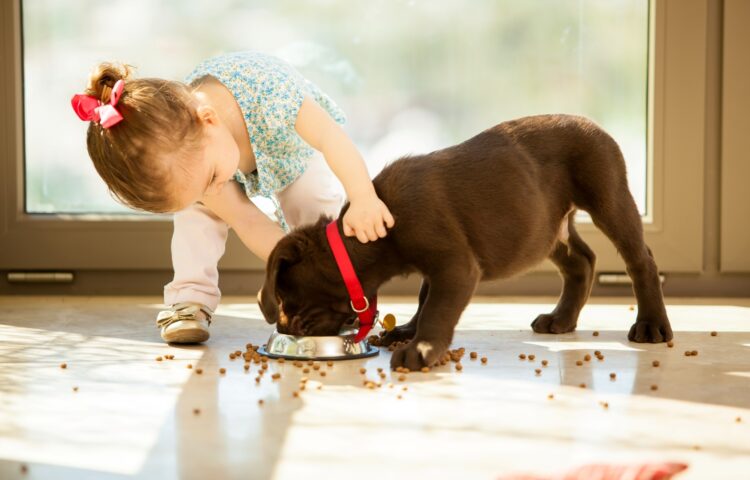For so many, dogs are our best friends and trusted companions. Despite how warm and loving they can be, all breeds of dogs are capable of biting. According to the Centers for Disease Control and Prevention (CDC), every year, more than 4.5 million people are bitten by dogs in the United States, and more than half of those bites happen at home with a familiar dog. Of those who endure dog bites, more than half are children under the age of 14 and nearly a million require medical attention.
Most dogs won’t bite without a reason. A family dog may bite when a new baby is brought home or a child plays too roughly, teases, or startles the dog. A dog you don’t know may bite when approached without taking the proper precautions. Knowing how to prevent dog bites will help keep your family safer this summer — and beyond.
Introducing Your Dog to Your Newborn
If you got your dog before having children, then in many ways it was your “first child.” Your pooch ruled the roost and was accustomed to receiving your full attention and affection. When you introduce a new baby into the family, your dog may not know how to adjust to this “new sibling.” To prevent any possible dog bites, it’s best to prepare your dog ahead of time for the baby’s arrival.
Before baby
Start to spend less time with your dog so that it’s prepared for the time and attention you’ll give to the new baby. That doesn’t mean ignoring your dog altogether — just tapering off the time spent doting on your beloved canine.
Also, when your baby arrives there will be a lot of new sounds, smells, and routines that will affect your dog. You can introduce these beforehand so that your dog isn’t surprised by them after the big day. Playing recordings of a baby’s crying and the different sound effects of baby products (e.g., swings, baby monitors, bouncer seats, mobiles) will prepare your dog so that it isn’t startled by these noises later on. You can also introduce smells like baby lotion, oil, or powder. And activities like taking the stroller on walks may help your dog adjust to the coming changes in routines.
After baby arrives
Once your baby’s born, bring home blankets and clothes the baby has worn or been swaddled with in the hospital so that your dog can smell and get accustomed to the new scent. Once home, mom should say hello to the dog first to kick off the introduction process. Begin associating your new infant with positive experiences for your dog. Incorporating treats into the process may also help. Always reward your dog’s good behavior.
To help prevent dog bites, always supervise whenever a dog is around your baby or any other child. Even “great dogs” that you’d never expect to bite may snap when they feel stressed, afraid, or surprised.
Teaching Your Children to Interact With Dogs (Familiar and Unfamiliar)
Coaching kids about how to approach and behave around dogs that they know and don’t know can help prevent dog bites. Again even your family dog, which may be very gentle and loving, may bite when provoked. And an unfamiliar dog may seem friendly at first, but if approached too quickly, may lash out.
Interacting with familiar dogs
Children younger than 10 years old should never be left alone with a dog, even if it’s the family dog or the child is familiar with the dog. When they are around dogs, teach your kids some big no-no’s for interacting with them. To help prevent dog bites, always avoid:
- squeezing too tight
- dropping them
- falling or jumping on them
- teasing them
- pulling on their ears or tails
- bothering or touching them while they’re eating, sleeping, caring for their puppies, or when they feel sick
- taking away a toy or bone
- playing tug of war
- crowding them or backing them into a corner
- feeding a treat with your fingers (Instead, hold the treat in the palm of your hand with all fingers close together.)
Interacting with unfamiliar dogs
When you don’t know the dog, all of the rules for familiar dogs still apply, but there are some additional steps to teach your kids. If they want to interact with someone else’s dog, teach them to:
- Always ask the owner if it’s OK to pet the dog. (Even dogs that are usually friendly, calm and gentle may sometimes behave differently when they’re stressed, not feeling well, or exposed to a new situation.)
- Approach the dog slowly and let it see you.
- Let the dog sniff you by putting your fisted hand out in front of you.
- Avoid petting the face, tail, and head.
- Avoid eye contact.
- Avoid running and yelling.
Identifying an Aggressive Dog
Knowing when a dog is being aggressive can help you to prevent a bite from happening. Here are signs that a dog may bite, and how to react when and if you’re confronted with an aggressive or attacking dog.
How to tell that a dog may bite
- whites of the eyes showing
- intense stare
- rigid body posture
- raised fur
- lips curled to show teeth
- growling
Teach your children that if they are approached by an unfamiliar dog, to quietly walk away. If the dog continues to advance, stand completely still like a tree.
What to do if your child gets bitten
If your child does get bitten by a dog, contact your doctor right away and follow any instructions.
- If the wound is small, clean it with soap and water, apply antibiotic cream, and cover it with a clean bandage.
- If the wound is deeper, apply pressure to stop the bleeding and call your child’s doctor or go to the emergency department if the bleeding doesn’t stop or your child feels faint.
- If the dog that bit your child is acting strangely or you suspect it may have rabies, be sure to let your doctor know.
This post was updated: April 12, 2017.



